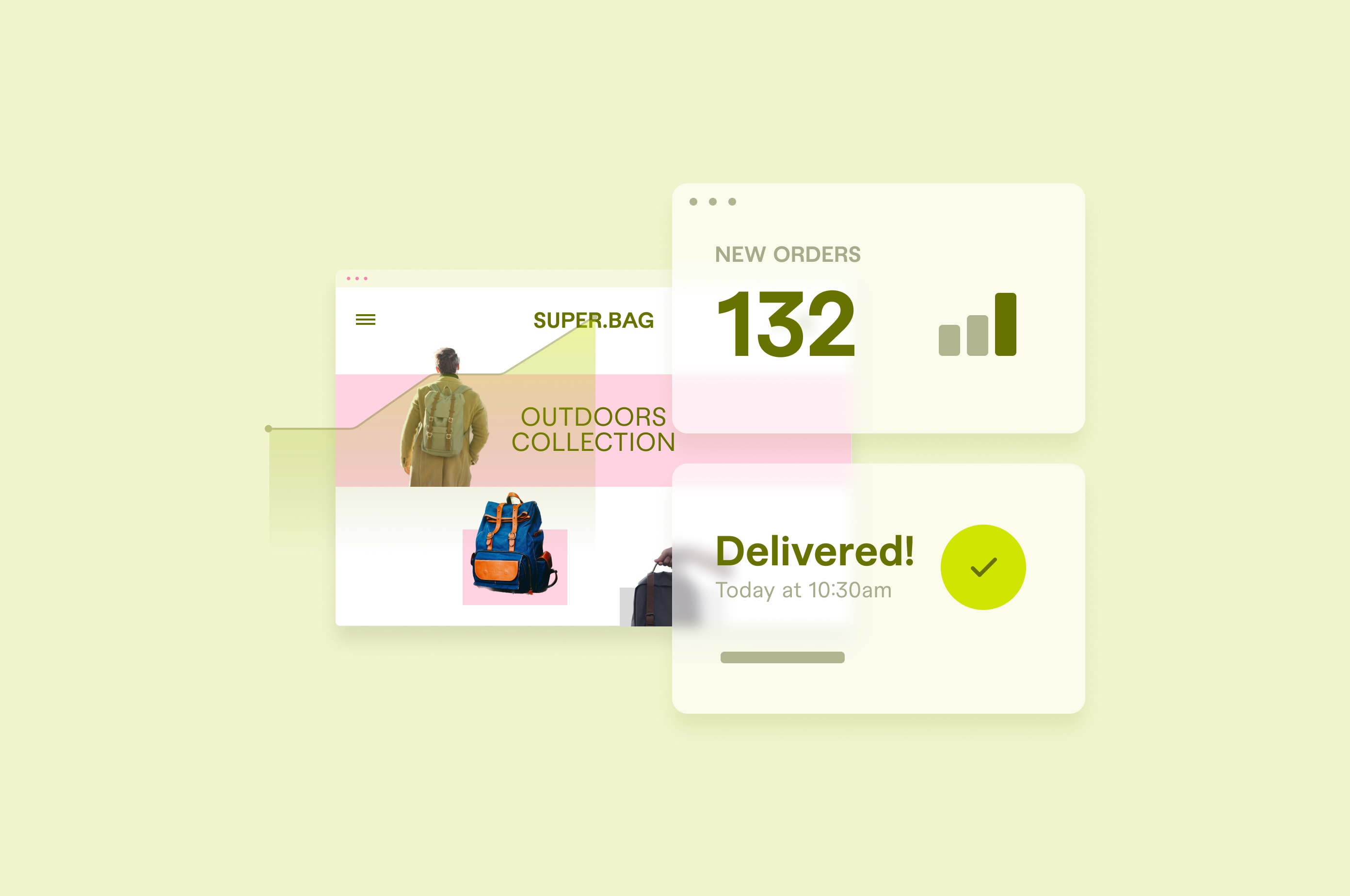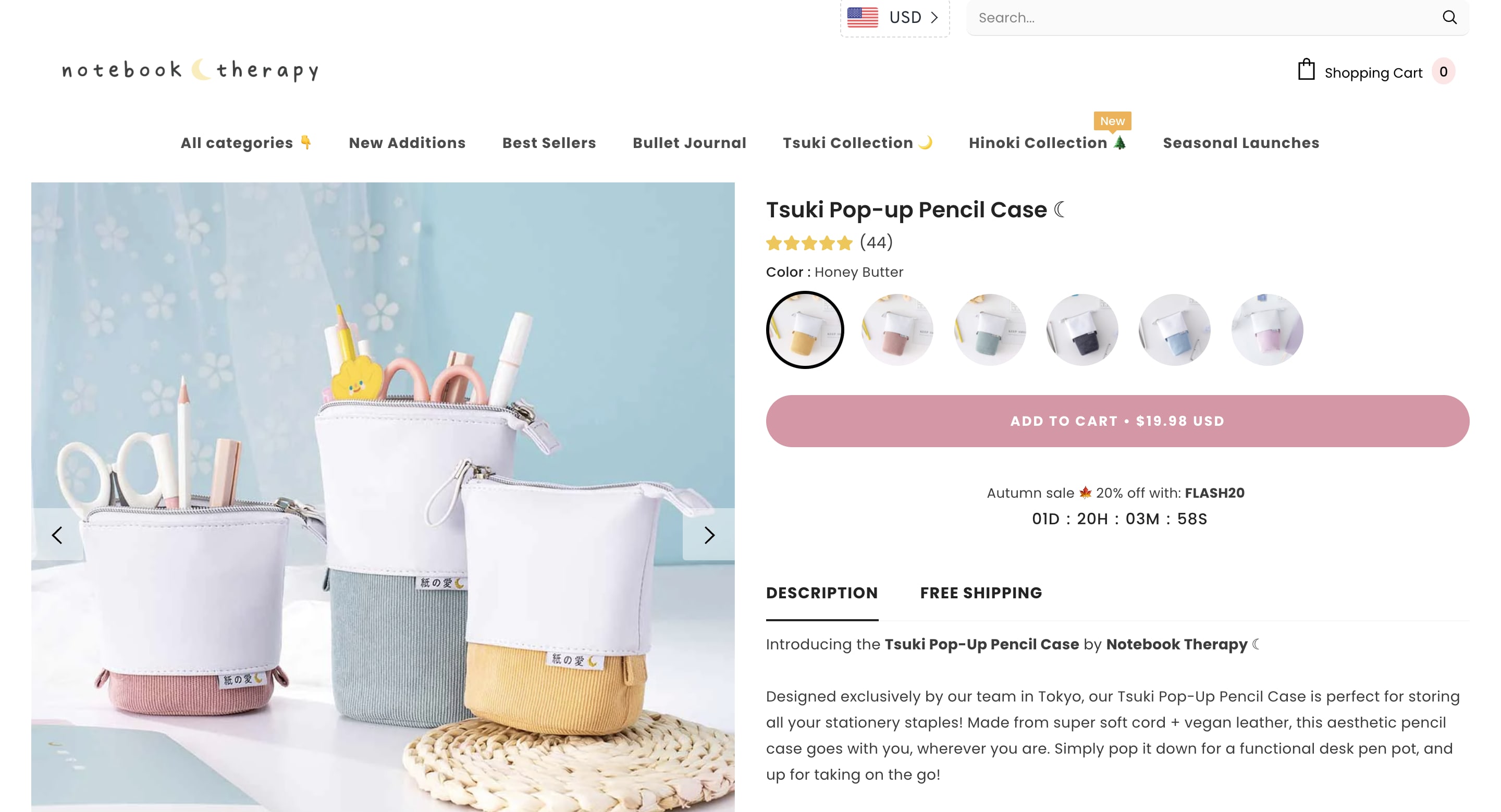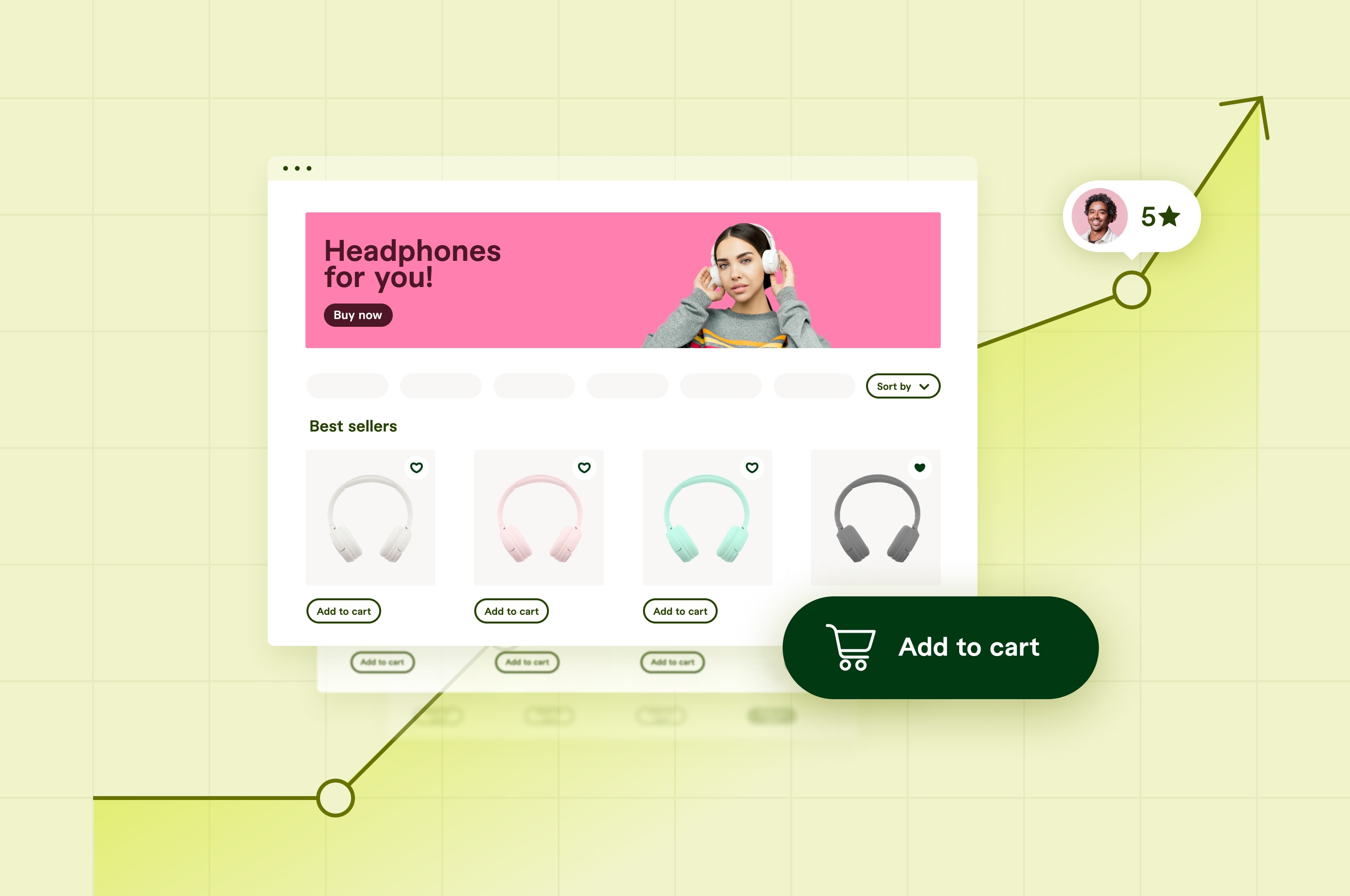Ecommerce Dropshipping: How To Get Started in 2023 (Tips and Tools)
Discover how to set up and run an ecommerce dropshipping business, plus tips for success.
 November 6, 2023
November 6, 2023 14 minute reading
14 minute reading
Up until recently, starting a retail business required a significant investment.
You had to find and rent a storefront, kit out the space, buy stock to fill the shelves, and buy radio or TV ads and billboards to market your business. Not to mention the high overhead costs that come running a physical store.
With ecommerce dropshipping, you don’t have to worry about fluctuating product demand or dead stock gathering in your warehouse—and it doesn’t require a lot of money to set up.
If you’re looking to break into ecommerce dropshipping, this guide covers everything you need to know to get started.
What is ecommerce dropshipping?
Dropshipping is an ecommerce business model where a merchant lists products on their website without stocking or shipping the products themselves. Then, a third-party supplier controls the supply chain and order fulfillment, and deliveries to the end customer.

Pexels
How does ecommerce dropshipping work?
Ecommerce dropshipping is the standard online business model, minus inventory management.
Here’s how it works:
A customer visits a merchant’s ecommerce website, browses the products that pique their interest, places an order, and then makes payments on the merchant’s site.
The merchant checks if the details are correct, then clicks the Order button to buy the ordered goods from a dropshipping supplier.
The supplier receives the order information, then picks, packs, and ships the item directly from their warehouse to the customer’s doorstep.
Then, the customer pays the merchant, who then pays the supplier.
The merchant profits from the markup on the sale.
In dropshipping, merchants focus on marketing and selling products in their online store, while dropshipping suppliers handle production, storage, and logistics.
Let’s say you start an ecommerce dropshipping store called Bochereë. Without buying physical stock, you list a range of high-end headphones on your site based on what dropshipping suppliers have in stock. Then, you price each pair at a 20% markup.
You market your store and attract a visitor who buys a pair of purple headphones for $250. You receive the order and payment and purchase that pair of headphones from a third-party supplier for $200. Then, you send an automated confirmation email to the buyer so they can track their order.
The supplier packs, ships, and delivers the customer’s purple headphones to their doorstep in perfect condition by the estimated delivery date and time. But the customer doesn’t know that two different businesses are involved in their shopping experience.
Bochereë profits $50 from the markup on the pair of headphones that was sold.
This streamlined order fulfillment approach makes it easy to start an ecommerce dropshipping business without:
Leasing warehouse space
Managing inventory
Juggling supply chains
Is ecommerce dropshipping legal?
Absolutely. Ecommerce dropshipping is a legal business model.
That said, many manufacturer agreements place the liability of dangerous or broken products on the merchant. For instance, if a supplier sends a faulty product to your customer that causes harm or injury, you may be liable for compensatory or punitive damages.
That’s why you need to work with trusted manufacturers or third-party suppliers and comply with local regulations.
In addition, different countries have varying tax policies and local regulations around prohibited items. So, a product may be legal in one country but illegal to ship to another. Research and understand the implications of international order fulfillment to different countries before setting up your business.
What are the benefits and drawbacks of ecommerce dropshipping?
Like any other business model, ecommerce dropshipping has its upsides and downsides.
Benefits of ecommerce dropshipping
Easy to start and scale: It’s easy to set up, launch, and operate an ecommerce dropshipping store from anywhere with an internet connection, computer, and ability to communicate with suppliers. And you can expand with less incremental work and low overhead costs.
Zero upfront inventory: Dropshipping eliminates the need for warehousing and handling inventory. Instead, suppliers handle stock, pack, fulfill, and deliver customer orders to their respective physical locations.
Minimal capital investment: You can launch an ecommerce store with little capital investment or spending thousands of dollars on physical products. Overhead expenses are also quite low, since you don’t have to purchase stock or manage fulfillment centers.
Array of products to sell: Because you don’t pre-purchase products, you can offer a wide selection of items on your site at no additional cost, and switch things up without worrying about dead stock.
No logistical headaches: You won’t have to worry about printing, packaging, and shipping products. Suppliers take care of the order fulfillment process and logistical needs until the customer receives the order.
Less risk: You don’t have money tied up in the stock of any item, so you’re not worried if they sell or not.
More agility: You can quickly act on customer behavior and feedback. If a product is popular among customers, offer similar items. If it doesn’t sell, don’t advertise it in your store.
More funds to invest in your store: With dropshipping, customers cover transaction costs and you get your profit from each sale. You can invest the funds in branding and marketing your store to attract more customers and boost sales.
Drawbacks of dropshipping
Limited control: As a dropshipper, you market and sell products in your store. You have little control over product quality or delivery timelines, which means your brand’s reputation is at the mercy of your supplier.
Low profit margins: The minimal capital outlay doesn’t always translate to higher profits, considering a chunk of the money goes to the supplier. This means you’ll have to put in more effort to stay afloat and cover site marketing, search engine optimization (SEO), and maintenance costs. Plus, your site traffic largely determines your profit, meaning you might struggle for a while as you build a customer base.
Shipping complications: Dropshippers often work with multiple suppliers, which comes with varied shipping costs to send each item. You may find it complicated to calculate separate shipping costs for each item if a customer buys different items from your store, and different suppliers fulfill them.
Supplier mistakes: Even the best supplier can make errors when fulfilling orders, like product quality or packing issues, which can damage your brand’s reputation.
Limited branding and customization: With dropshipping, you have no control over the product or its packaging. The supplier packs and ships it with their own branding, giving them more control over the product itself.
Done right, ecommerce dropshipping can be a lucrative business. Let’s go over the steps you need to take to get set up.
How do I start an ecommerce dropshipping business?
Whether you’re setting up a new ecommerce store from scratch or need a secondary income stream, here’s how to get started with ecommerce dropshipping step by step.
1. Pick a niche
An ecommerce niche is a specific, distinct market segment that’s often overlooked by other businesses. For example, if you want to sell t-shirts, you could pick retro t-shirts as a niche.
Honing in on a niche involves identifying the gap in a less competitive market segment with high growth potential. This way, you can:
Build stronger customer relationships
Lower operating costs
Enjoy higher profit margins
The niche you choose should make business sense. Through market research, you can check demand and analyze if the niche you’re considering is profitable.
“I have always had a passion for adding aftermarket products to my vehicles,” says Ryan Horton, co-founder of Truck Brigade—an online store that deals in overland and off-road gear. “Overland parts and accessories were starting to pop up in the 2015 to 2016 time frame, and there was not a one-stop shop out there where you could pick up all the parts needed for a build. At that time, you needed to buy each product from the specific company, which resulted in many unnecessary transactions. With that in mind, we decided to create Truck Brigade, which was the first one-stop shop for overland parts and accessories for the most off-road oriented vehicle models on the market.”
You can search a product on Amazon to see how many results show up, their wholesale prices, and user reviews. Or use Google Trends to test your business idea and find:
Consumer interest in a product over time
If and when a product is trends upward or downward
Related queries
Similar products
While Google Trends doesn’t show search volumes, you can use keyword research tools like Semrush,Ahrefs, or Keywords Everywhere to know the monthly search volumes for a product and its competitiveness. Plus, you’ll gauge how popular your ecommerce business idea is and get inspiration for product ideas.
2. Conduct competitive research
Next, conduct competitive research to know which businesses you’re going up against, how they work, and the current ecommerce trends. Then, develop a solid marketing plan for your ecommerce dropshipping business.
If there are many competitors in your chosen niche, focus your research on two big players, like Amazon, eBay, and three other dropshipping companies.
Here are some ways to build your competitor list:
Run an online search using key search terms, noting the top 10 results and how they promote their dropshipping products.
Use keyword research tools to find location-specific keyword data
Find and monitor your competitors’ activity, site traffic, and other data using Alexa, Similarweb, or other competitor spy tools.
Browse social media pages for businesses in your chosen niche to find out the top ecommerce brands in the market and learn their social media marketing strategy.
Note your competitors’ marketing methods, product descriptions, pricing strategy, and user sentiments to inform your strategy.
Order products from your competitors to know what sets them apart and observe any of their flaws to improve them for your customer experience.
3. Choose a dropshipping supplier
The next, most important step is to find a reliable dropshipping supplier who offers quality products, does their job well, and fulfills orders punctually and efficiently.
Some factors to consider when selecting a supplier include:
Markets they sell from
Quality of their products
Industry experience
Fee structure and pricing terms
Order fulfillment and shipping times
Technological capabilities
Customer support channels
Return policies
Product warranties and guarantees
Helpful, dedicated sales and support representatives
Browse the suppliers’ websites, read user reviews, and check vetted supplier directories to narrow down your options. Then, reach out to each of the suppliers you’ve identified and ask relevant questions to know if they’re a great fit for your business.
“A key contributor to our success is the strict selection of suppliers and a well-planned customer service strategy,” says Wendy Wang, owner of F&J Outdoor, an outdoor-furniture-cover brand. “We believe in providing our customers with high-quality products and ensuring an excellent shopping experience that makes them return. We decide what to sell based on market trends, customer demand, and season. For instance, our bestsellers are the patio rectangular table and chairs furniture set cover, and the 2023 edition patio round cover. Our products are sourced from reliable manufacturers in different parts of Asia, based on their product quality, reputation, and commitment to sustainability.”
Ecommerce dropshipping platforms like WooCommerce and Shopify let you connect DSers, a dropshipping management tool that connects to AliExpress, to your store and find potential suppliers.
Once you find a few reliable suppliers, use product research tools like AliShark, Sell The Trend, or Niche Scraper to source products to sell online. These tools analyze products across different platforms and marketplaces, so you can find bestselling products along with data on market trends and customer demand.
4. Build your ecommerce store
Ready to build your ecommerce dropshipping website? Start by picking an ecommerce platform for your dropshipping business.
On your site, you’ll display and sell products, send traffic, and process customer payments.
There are free and paid website builders you can use to set up and launch an ecommerce store. The provider you choose should support your sales in multiple locations, currencies, and payment methods.
To set up your site, you’ll need the following:
Domain name
Website theme and template
Content management system (CMS), like WordPress or Squarespace
Marketing and security plug-ins
Integration with your preferred dropshipper
Checkout and cart management features
Built-in payment gateway
Need help building your ecommerce website? Hire a website designer and website developer from Fiverr to create and build a beautiful online store that attracts shoppers and drives sales.
5. Choose a business entity
It’s not enough to have a good product, trusted supplier, and beautiful website. You’ll need to set up a proper foundation and legitimate business structure to ensure your business succeeds—and protect yourself if something goes wrong.
The most common business structures are:
Sole proprietorship
Limited liability company (LLC)
C corporation
Legal requirements vary from one location to another. For example, if you’re in the US, you’ll require an employer identification number (EIN), which is needed when filing taxes, opening a bank account, and other business-related matters.
6. Market your store
Once you set up your store and register your business, you’ll need to attract customers to visit and make purchases.
To stand out in your niche, create a marketing and advertising budget to promote your store through:
Paid ads on search engines and social media platforms
Content marketing
Mobile marketing
Marketing in communities and online groups/forums
Monitor the channels that work best for your business so you can optimize and adjust your marketing strategy to reduce costs and maximize profits.
7. Analyze your store’s performance
At the end of each day, week, or month, open your store’s analytics or reports page to analyze any recent activity and the results of your marketing/advertising efforts.
Some metrics to track include:
Sales: Find which channels perform best, the bestselling products, and the top customers. This will inform where you should focus your marketing efforts and budget.
Customer behavior: Check whether your customers purchase more from a desktop or mobile device, and the conversion rate for each device.
Profit margins: Look at the most profitable products and variant stock-keeping units (SKUs), as well as your month-over-month sales and gross profits.
Use this data to ensure your overall strategy is working and create even more specific segments and marketing campaigns. Tools like Google Analytics and Search Console are useful for measuring search traffic over time and improving your marketing and ecommerce SEO efforts.
Tips for building a successful ecommerce dropshipping business
Dropshipping is a great option for aspiring entrepreneurs. While it has fewer complexities than traditional business models, it takes time, effort, and money to set your business up for success.
We interviewed ecommerce store owners on how to start and grow a successful dropshipping business. Below are some tips they shared:
Test different products and ad creatives to decide what works and what doesn’t.
“If you try a product and it doesn’t work, move on to other products until one is successful,” says Cameron Heinz, owner of Mobility Nest, an online mobility store. “Try different ad creatives, too.I know people that didn’t find their first winning product until after 35 product attempts. That means they must’ve researched 35 products, built entire pages and/or websites for each product, and made ads for each until they found the winner.”
Build strong relationships with reliable suppliers.
“We source our products from AliExpress and domestic suppliers, chosen for their reliability, quality, and fair pricing,” says Gareth Boyd, founder of Boyd Hampers, a gift basket online store. “Be transparent with your suppliers and integrate them with your ecommerce platform for near-seamless operations.”
Consider profit margins and costs, then price competitively.
“Calculate the cost of sourcing or producing products, including manufacturing, shipping, and any associated fees,” says Eric Jones, CEO at Couture Candy, a special occasion fashion ecommerce business. “Ensure you can price your products competitively while maintaining healthy profit margins.”
Monitor market trends and customer preferences and adapt accordingly.
“We closely monitor market trends and customer preferences,” says Saj Munir, owner of Chorlton Fireworks, an online fireworks supplies store. “For example, during the COVID-19 pandemic, we noticed a surge in interest in backyard fireworks displays. We quickly adapted and featured these products prominently on our website, resulting in a 30% increase in sales in the first quarter of 2020.”
Implement automated systems for speed and efficiency.
“Efficiency in dropshipping operations is often achieved through automation, utilizing tools and software to streamline order management, inventory tracking, and customer communication,” says Jaime Ghisays, CEO at All Print Heads, an online printer spare parts and consumables store.

Your Ecommerce video? Done.
Let Fiverr freelancers create engaging social media videos for your Ecommerce business. Video ads, product videos, tutorials, corporate videos and more.
Hire freelancersLaunch your ecommerce dropshipping business
Dropshipping is a low-cost, low-risk business that works well for startups, small businesses, and big brands, too.
With a solid business plan, good marketing strategy, reliable suppliers, and profitable niche, you’ll increase your chances of success.
Need help getting set up? Fiverr’s digital marketplace gives you access to ecommerce professionals who can do everything from picking a niche to conducting market research to building an online store to data analysis, and more. Plus, you can manage all your project files, freelancers, and payments in a single dashboard for free.
Sign up for Fiverr to find ecommerce dropshipping experts for your project.




